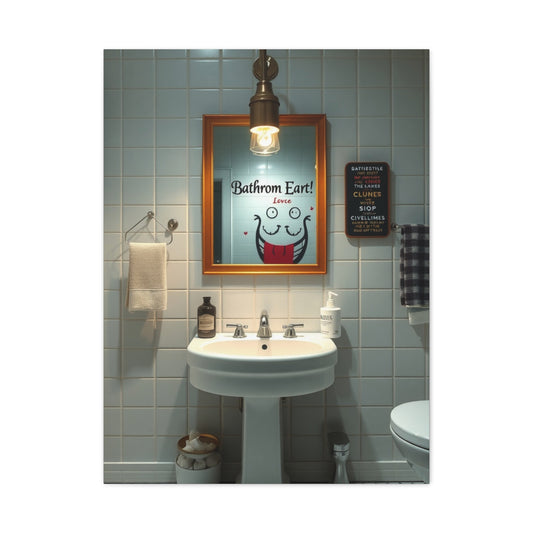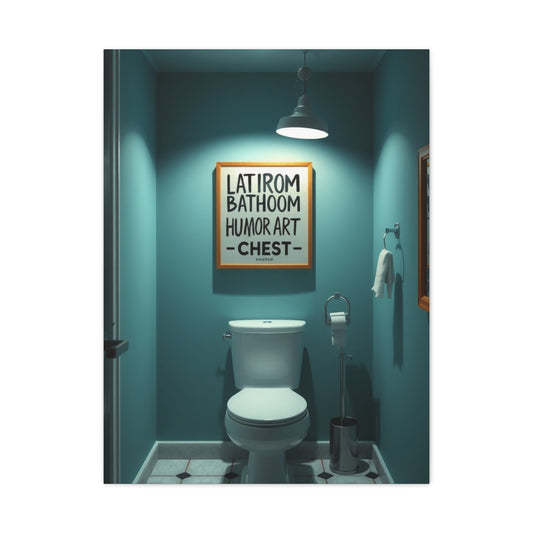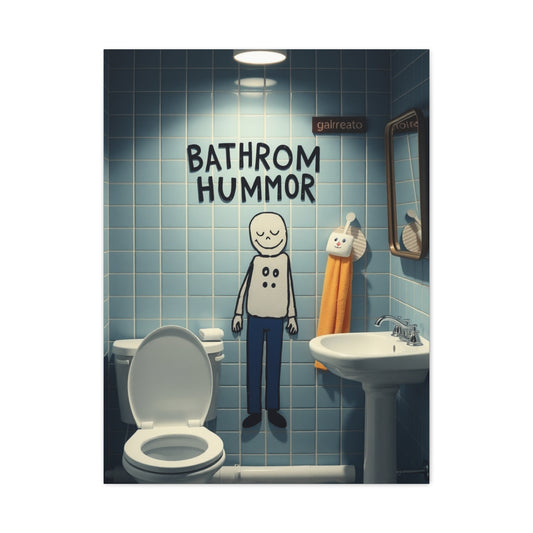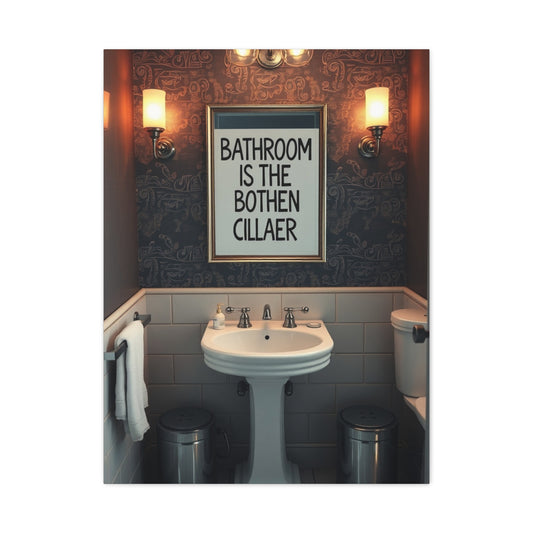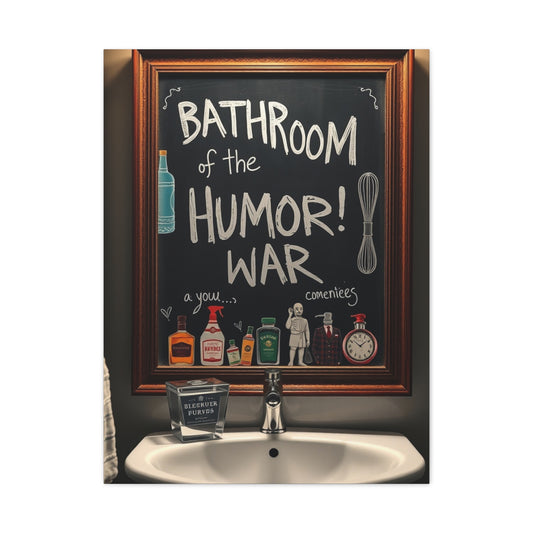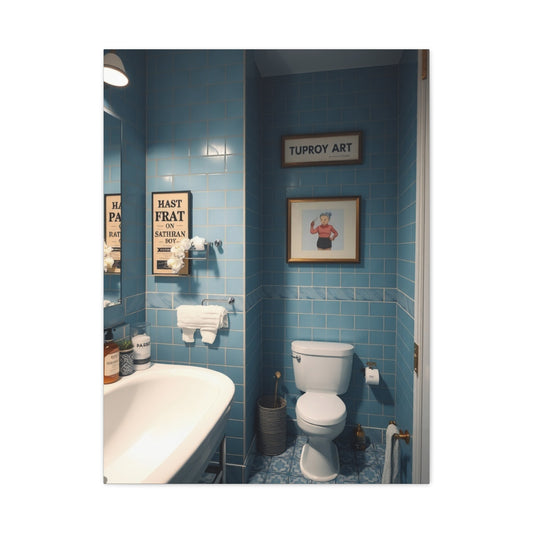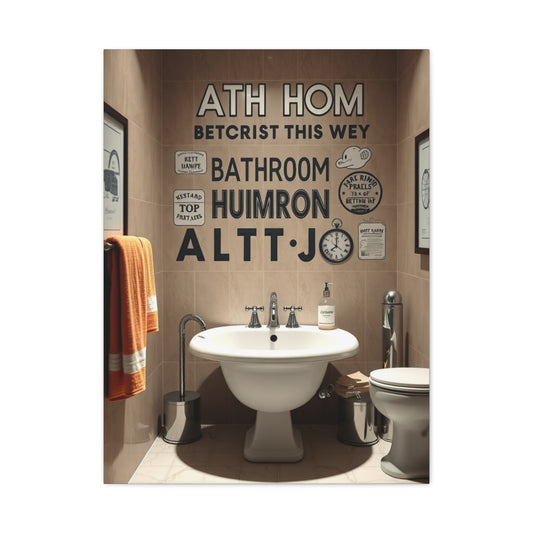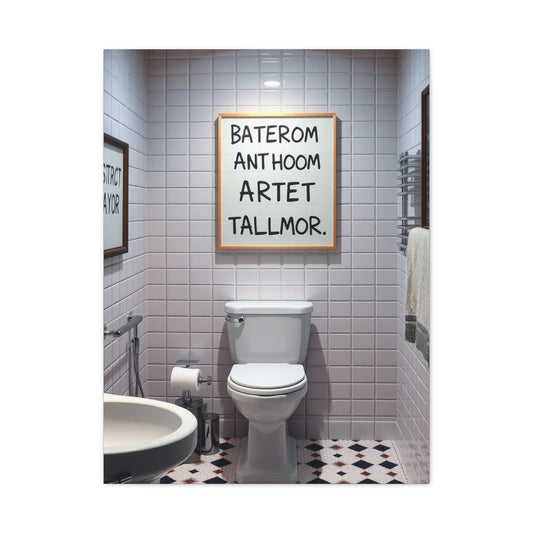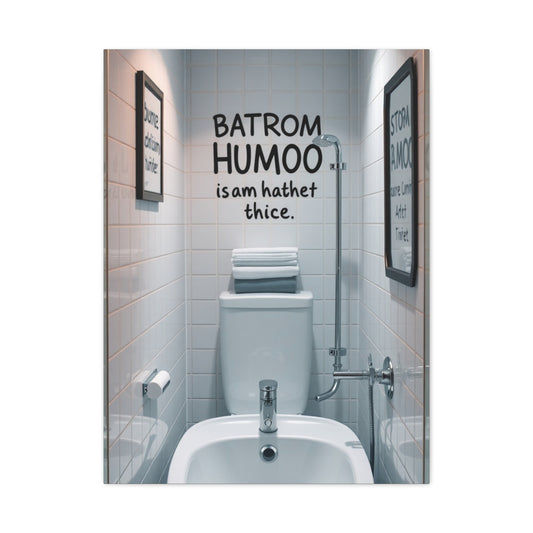The Impact of Humor in Artistic Expression: How Comedy Elevates Bathroom Wall Art and Other Creative Works
Humor possesses a remarkable and almost magical quality that enables it to seamlessly intertwine with the fabric of our daily lives. It acts as a subtle but powerful force that eases tension, lightens moods, and fosters genuine connections between individuals. This inherent ability of humor to diffuse stress and bring people together is well documented in social interactions, but when humor finds its way into the realm of art, its impact deepens profoundly. Whether humor manifests in painting, literature, music, theatrical performance, or various forms of mixed media, it transcends mere entertainment. It becomes a transformative tool—one that disarms entrenched perspectives, jolts audiences with unexpected insights, and at times, facilitates profound emotional healing and reflection.
Throughout my experience with creative work, I’ve come to understand that humor is far more than a decorative flourish or a momentary spark of amusement. Instead, it stands as a formidable strategic element within the artistic process. Incorporating humor deliberately in art does not merely entertain; it sustains and intensifies audience engagement over time. It leaves a lasting impression, making the artwork not only memorable but also deeply impactful. This strategic use of humor acts as a bridge, linking artist and audience through shared recognition of life’s absurdities, ironies, and contradictions.
Crafting humor in art, however, is no simple task. Eliciting laughter or amusement requires a certain finesse—an intricate dance along a slender tightrope between cleverness and triviality, charm and coarseness. It demands sensitivity and an acute awareness of context, timing, and audience perception. When executed with mastery, humor transcends these challenges to forge an intimate, almost conversational bond between creator and viewer. This bond elevates the artistic experience beyond passive observation, transforming it into an active, engaging dialogue filled with warmth and connection.
For artists—whether they are seasoned veterans with years of practice or emerging creatives tentatively exploring new expressive territories—embracing humor can serve as a potent catalyst for innovation and resonance. It breathes vitality into their work, inviting viewers to engage with the art on multiple levels. Humor enriches the narrative by injecting layers of meaning that stimulate both the intellect and the emotions. This multifaceted approach ensures that the art does not simply pass by unnoticed but instead lingers in the minds of its audience, inviting contemplation and repeated engagement.
Instant Rapport Through Laughter: How Humor Bridges Artist and Audience
Humor holds a unique and powerful place in the realm of art, functioning as a bridge that instantly connects creators with their audiences. Unlike more abstract or intellectual approaches that may require prolonged contemplation, humor cuts through barriers with remarkable speed, sparking a shared emotional response that fosters a sense of unity and understanding. Imagine walking into an exhibition space and being greeted by a painting or installation that immediately provokes a knowing smile or spontaneous laughter. Whether it’s a cleverly satirical comic or a visual pun that gently pokes fun at societal quirks, this reaction is no accident—it’s the product of careful artistic intention.
At its core, humor in art serves as an emotional key, unlocking the audience’s receptiveness and openness almost immediately. This effect is profound because it bypasses critical or defensive reactions that viewers might otherwise have when confronted with challenging or unfamiliar themes. Instead, laughter softens those defenses, creating a welcoming atmosphere where viewers feel invited rather than judged. It’s this unique capacity to lower barriers that makes humor an invaluable tool for artists who want to engage diverse audiences quickly and deeply.
Laughter functions much like a social lubricant in human interactions, smoothing the way for communication and connection. In an art context, humor achieves this by transforming the experience from something potentially intimidating or inaccessible into one that feels approachable and relatable. I’ve often observed audiences who initially appeared reserved or disinterested suddenly become animated and involved when a subtle joke, clever visual twist, or witty commentary emerges within a piece. This immediate shift in engagement demonstrates how humor can capture attention far more effectively than dense narratives or lengthy explanations, which sometimes risk losing viewers’ interest.
Elevating Serious Themes Without Compromising Depth
Humor holds a unique and powerful place in the realm of art, serving purposes far beyond mere entertainment or lighthearted amusement. While some may mistakenly believe that humor diminishes the seriousness or importance of an artwork’s message, the opposite is often true: well-executed humor can deepen the impact of serious themes and amplify their resonance. Through irony, satire, and dry wit, humor layers additional meaning and complexity onto art, inviting viewers to engage in thoughtful reflection and critical analysis.
One of the reasons humor is so effective in elevating serious themes is its ability to operate on multiple levels simultaneously. On the surface, a humorous artwork may provoke laughter or amusement, creating an immediate emotional connection with the audience. However, beneath this initial response lies a more profound and often unsettling insight that stays with the viewer long after the laughter subsides. This duality allows humor to disarm viewers, lowering their defenses and opening them up to challenging ideas that might otherwise be met with resistance or discomfort.
Consider the work of street artists who masterfully blend humor with biting social commentary. These artists use playful or exaggerated visuals to grab attention and entertain, drawing viewers in with a sense of familiarity and levity. Yet, once engaged, the audience is confronted with a deeper message about societal issues such as inequality, injustice, or political corruption. The humor serves as a gateway, making complex or uncomfortable topics more accessible and digestible. This strategic use of humor encourages viewers not just to passively enjoy the artwork but to actively reflect on the underlying critique, fostering awareness and dialogue.
Irony and satire are particularly potent tools within this framework. By highlighting contradictions, absurdities, or hypocrisies through humor, artists can expose truths that might otherwise be overlooked or ignored. Satirical works, for example, mock societal norms or power structures, revealing flaws and prompting critical examination. The humor in these works is often sharp and incisive, demanding a certain level of intellectual engagement from the audience. As a result, the humor becomes a catalyst for deeper understanding rather than a distraction from serious content.
Humor as a Creative Safety Net Encouraging Bold Innovation
Sharing creative work with the world is an act of vulnerability. Artists, writers, designers, and creators open themselves up to judgment, critique, and sometimes misunderstanding. This exposure can bring anxiety and fear, especially when the work pushes boundaries or explores unconventional ideas. In this emotionally charged landscape, humor often emerges as a crucial tool—a creative safety net that cushions the risk of rejection and encourages bolder experimentation.
Humor serves as a protective layer for creators in several ways. When artists infuse their work with absurdity, satire, or playful elements, they essentially give themselves permission to take chances without the full weight of seriousness hanging over their heads. This lightness allows them to explore ideas that might otherwise feel too risky or controversial. The presence of humor signals to both the creator and the audience that the work isn’t bound by traditional expectations, opening the door to innovation and surprise.
One powerful aspect of humor in creative work is its ability to diffuse criticism. If a piece doesn’t resonate or is met with skepticism, the artist can lean on the humorous element as a kind of shield. “It was just a joke,” or “I’m not taking myself too seriously,” becomes a way to soften potential backlash or misunderstandings. This reframing doesn’t diminish the work’s value; rather, it provides emotional breathing room, allowing the artist to continue experimenting without being paralyzed by fear of failure or rejection.
Conversely, when humor connects with an audience, it significantly amplifies the impact of the creative work. Humor invites engagement—it creates a shared moment of recognition, amusement, or insight. This connection transforms passive viewers into active participants, sparking conversations and deepening the emotional resonance of the piece. Humor often makes challenging or abstract ideas more accessible, enabling artists to communicate complex messages in a relatable, memorable way.
Take, for example, the experience of a painter friend who traditionally worked in somber, introspective tones. By gradually incorporating whimsical cartoon motifs into his paintings, he introduced a playful contrast that shifted the audience’s experience. These lighthearted elements didn’t dilute the seriousness of his work; instead, they opened new avenues for interpretation and interaction. Viewers found themselves drawn in not only by the emotional depth of the paintings but also by the unexpected humor sprinkled throughout. This blend encouraged lively discussions and helped the artist reach a wider, more diverse audience.
Humor’s role as a creative safety net also extends to innovation within established genres. In fields where conventions are deeply entrenched, incorporating humor can be a subtle yet powerful way to challenge norms without alienating audiences. For instance, satirical cartoons or ironic sculptures poke fun at cultural clichés, social issues, or artistic traditions, prompting viewers to reconsider familiar ideas through a fresh lens. By laughing, audiences become more open to questioning assumptions, making humor a catalyst for change.
Articulating the Unspoken
Humor is a timeless and universally recognized tool that has long been used to navigate and articulate difficult, sensitive, or controversial subjects. It acts as a bridge—connecting people across divides of discomfort, resistance, or fear—by providing a softened entry point into conversations that might otherwise be ignored or met with hostility. Whether through satire, parody, irony, or witty commentary, humor allows artists, writers, performers, and communicators to critique societal injustices, political dynamics, and cultural taboos in ways that are both accessible and impactful.
One of the fundamental reasons humor is so effective in this context is its unique ability to lower psychological defenses. When people laugh, their guard comes down, if only momentarily. This temporary easing of tension opens the door for messages to be received with less immediate judgment or defensiveness. In other words, laughter can act as a disarming mechanism, permitting uncomfortable truths to be heard, processed, and even embraced. This dynamic makes humor an especially potent vehicle for conversations about issues that might otherwise provoke anger, denial, or silence.
Political cartoons serve as a classic and powerful illustration of this phenomenon. These illustrations distill complex social and political critiques into bite-sized, often humorous images that simultaneously entertain and provoke thought. The humor in political cartoons sharpens social commentary, turning criticism into something palatable and memorable. Because these cartoons frequently exaggerate or caricature their subjects, they provide a form of catharsis for audiences, while also encouraging reflection on serious topics such as corruption, inequality, and injustice.
Beyond political cartoons, humor’s role in performance art, film, literature, and photography further underscores its capacity to articulate the unspoken. Comedic elements woven into these art forms create a “stealthy conduit” for addressing controversial or sensitive issues. For instance, films that employ satire or dark comedy can expose societal flaws, challenge stereotypes, or critique cultural norms without alienating their audiences. The humor acts as a lens that reveals difficult truths in a way that feels engaging rather than confrontational.
Preserving the Artist’s Sanity
Artistic creation is often a deeply emotional and intense endeavor. Artists frequently immerse themselves in complex, heavy, or personal themes that demand considerable mental and emotional energy. While this immersion can lead to profound insights and powerful work, it also carries the risk of fatigue, frustration, and creative blocks. When the process becomes overwhelming, it can stifle the very passion and spontaneity that fuel artistic expression. In this context, humor emerges as a vital and therapeutic tool — a refreshing antidote that can preserve an artist’s sanity and sustain creative vitality.
Incorporating humor into creative practice allows artists to approach their work with a lighter heart and a more playful spirit. Humor invites experimentation and playfulness, encouraging artists to break free from rigid expectations and perfectionism. By poking fun at personal frustrations, exaggerating flaws, or simply embracing absurdity, artists give themselves permission to make mistakes and explore new ideas without fear. This sense of freedom often leads to joyful discoveries and rekindles the original excitement that inspired their craft.
Personally, many of my most beloved creations have emerged from moments when I consciously decided to abandon seriousness and embrace whimsy. These lighthearted experiments — whether through humorous sketches, playful narratives, or exaggerated caricatures — brought me genuine amusement. That joy was not just a private pleasure; it translated into authenticity in the work itself. Audiences often respond to this authenticity, recognizing the artist’s genuine enjoyment and openness. Humor, in this way, becomes a bridge that connects the artist’s inner world with the viewer’s experience.
Beyond just making the creative process more enjoyable, humor serves as a powerful emotional release. The creative journey is often riddled with self-doubt, fear of failure, and internal criticism. Humor acts like a pressure valve, allowing artists to laugh at their struggles instead of being crushed by them. This shift in perspective can break cycles of negativity and prevent burnout, making it easier to sustain long-term creative efforts.
Historically, many renowned artists and artistic movements have embraced humor as a crucial part of their work. For example, the Dadaists deliberately used absurdity and satire to challenge conventional art and society, infusing their pieces with playful irreverence. Similarly, cartoonists and satirists have long harnessed humor to critique social and political issues, demonstrating that humor can coexist with seriousness and depth. These examples remind us that humor is not a trivial distraction but a sophisticated and effective means of expression.
Genuine Humor Stems from Authenticity, Not Forced Gags
Humor is a powerful tool in art, storytelling, and communication. It has the unique ability to connect people, lighten serious moments, and reveal deeper truths through laughter. However, one of the most common pitfalls artists, writers, and performers encounter is the attempt to manufacture humor artificially—through forced jokes or contrived gags. These forced attempts at humor often fall flat because they lack the essential ingredient that makes humor work: authenticity.
Forced humor is easy to spot because it feels mechanical, rehearsed, or disconnected from genuine experience. When a joke is forced, it often appears as if the creator is ticking a box—“I need a joke here”—rather than naturally letting humor arise from the situation or their perspective. This artificiality creates a barrier between the audience and the work. People have an innate ability to detect sincerity, and when humor feels inauthentic, the laughter it produces is usually superficial or absent altogether.
In contrast, authentic humor springs from honest observation and genuine engagement with the world. It’s about noticing the quirks, ironies, and absurdities in everyday life and reflecting on them with a sense of insight and warmth. This kind of humor isn’t about trying to be funny for its own sake. Instead, it’s a natural expression of how someone sees and experiences the world. For example, a comic strip that highlights the awkwardness of social interactions or a film scene that captures the chaos of family life resonates because it’s rooted in recognizable truths. The audience laughs not just because the situation is funny, but because they see their own experiences mirrored in an honest way.
The key to authentic humor is the unique perspective of the creator. Instead of imitating popular comedians or relying on clichés, authentic humor involves channeling one’s own voice and worldview. This personal touch makes the humor distinctive and relatable. It reflects a nuanced understanding of human nature and society. When an artist draws on their real feelings and insights, the humor becomes a bridge that connects them with their audience, building trust and rapport.
This is why some of the most impactful humorous art uses elements of the absurd or unexpected—not merely for shock value, but to challenge conventional thinking. The humor in such works often arises from truthful commentary disguised in surreal or exaggerated forms. For instance, satire frequently uses exaggeration or absurdity to highlight social injustices or cultural contradictions. The laughs come from the recognition that beneath the ridiculous surface lies an uncomfortable truth. This makes the humor meaningful and thought-provoking, rather than shallow.
Balancing Audience Awareness with Artistic Integrity
Humor is a complex and nuanced form of expression, especially in artistic contexts. It holds a unique power to connect, challenge, and provoke thought, but it also requires careful navigation due to the diverse nature of audiences. What may elicit laughter from one group can evoke discomfort, offense, or confusion in another. This diversity in reception is a fundamental reality artists must consider when incorporating humor into their work. However, the challenge lies in balancing audience awareness without compromising artistic integrity.
Understanding the context and background of one’s audience is undeniably important. Different cultures, social groups, and individuals bring varied values, beliefs, and sensitivities to the table, all of which influence how humor is perceived. An artist who is mindful of this can tailor aspects of their work to engage effectively with their audience, ensuring that their message resonates and is accessible. For instance, humor that draws on shared experiences or cultural references can build rapport and foster a sense of community. In such cases, audience awareness acts as a bridge, facilitating connection.
Yet, there is an inherent risk in overemphasizing audience appeasement. Attempting to satisfy every possible viewpoint can lead to creative dilution, where the humor becomes watered down to the point of blandness. This “lowest common denominator” approach often strips humor of its edge, sharpness, and vitality, rendering it safe but forgettable. In striving to avoid offense or discomfort at all costs, artists might unintentionally stifle their own creative voice, producing work that lacks originality or emotional impact. This is particularly problematic because humor, at its best, often thrives on pushing boundaries and challenging norms.
The most memorable and impactful humor in art frequently embraces discomfort. It is humor that provokes reflection, questions societal taboos, and sparks conversations—even when it unsettles some members of the audience. This kind of humor requires courage on the part of the artist, who must prioritize meaningful engagement over universal approval. By daring to be provocative, the artist invites the audience into a space of critical thinking and emotional complexity. Such humor can illuminate uncomfortable truths and offer fresh perspectives, fostering growth and empathy.
However, embracing provocative humor does not mean ignoring the sensibilities of the audience. Thoughtfulness is key—it is not about reckless offense but about intentionality. Artists should consider the potential impact of their work, weighing the value of the humor against possible harm or misunderstanding. This process is not about censorship but about responsible creativity. Provocative humor should be included with a clear purpose, serving the art’s broader message rather than merely seeking shock value or cheap laughs.
Trust in one’s creative voice is essential in this balancing act. An artist who deeply understands their intent and artistic goals can better navigate the tension between audience reception and integrity. Respecting viewers’ sensibilities while remaining authentic enables a dynamic dialogue—one where humor acts as both a mirror and a lens. It reflects societal realities and personal experiences while also magnifying aspects that warrant deeper scrutiny.
Ultimately, balancing audience awareness with artistic integrity is a nuanced endeavor that requires sensitivity, courage, and thoughtfulness. It calls on artists to be attuned to the diversity of their audiences without sacrificing the distinctiveness and honesty of their creative expression. When done well, this balance results in humor that is not only entertaining but also transformative, fostering connection, insight, and meaningful conversation.
Embracing Humor Across Artistic Mediums and Genres
Humor is a universal language that transcends boundaries of culture, language, and form, making it a powerful tool in the realm of art. Across diverse artistic mediums and genres, humor enriches creative expression by engaging audiences on an emotional level, providing relief, and encouraging fresh perspectives. Whether it is visual art, literature, film, or sculpture, humor weaves its way into the fabric of creative work, offering a dimension that can entertain, critique, and challenge societal norms.
In visual arts, humor often manifests through irony, satire, and playful subversion of expectations. A single image can deliver a punchline as effectively as a joke told in words. For instance, a painter might juxtapose classical motifs with contemporary absurdity to create an image that simultaneously invokes tradition and irreverence. This contrast not only evokes laughter but also invites viewers to reconsider the conventions and hierarchies often rigidly upheld in the art world. Artists like Banksy have famously employed humor and irony in street art, using witty imagery and clever captions to comment on politics and social issues. This form of humor engages viewers by providing an unexpected twist, making them pause and think critically about the message.
Writers, on the other hand, wield humor through language itself. Witty turns of phrase, puns, satire, and absurd scenarios pepper novels, short stories, and plays, transforming narrative into a playground for laughter and insight. The literary genius of authors such as Mark Twain or Oscar Wilde lies not only in their storytelling but also in their ability to embed humor that reveals deeper truths about human nature and society. Humor in literature often relies on timing—the careful placement of punchlines or comedic situations that build anticipation before delivering the laugh. This timing, combined with contrast between expectation and reality, creates moments of delight and connection between writer and reader.
In cinema, humor is a multifaceted tool that directors and screenwriters use to shape narratives and develop characters. Comedic films and scenes depend heavily on timing, physical comedy, and dialogue to elicit laughter. Classic slapstick comedians like Charlie Chaplin used exaggerated physical movements and absurd scenarios to entertain, while modern filmmakers like Wes Anderson use dry wit and quirky characters to generate humor with subtlety and style. Humor in film often serves to humanize characters, making them relatable and accessible to audiences. Moreover, comedic elements can diffuse tension and make difficult or controversial subjects more approachable, creating a space for reflection through laughter.
Sculpture, too, embraces humor, sometimes in unexpected ways. Three-dimensional art can incorporate absurdity by presenting forms that challenge conventional aesthetics or by placing sculptures in surprising contexts. For example, an installation featuring a traditionally dignified figure crafted in an exaggerated or cartoonish manner can provoke amusement while simultaneously encouraging viewers to question the seriousness with which society treats certain subjects. Such absurd installations often invite a double take—initial confusion followed by realization and amusement. The tactile and spatial nature of sculpture allows humor to engage the viewer physically, creating an interactive experience that can be both playful and thought-provoking.
Even within traditionally solemn and prestigious artistic settings, humor finds a way to break through rigidity and invite accessibility. In museum exhibitions or galleries where art might be perceived as serious or inaccessible, a well-placed humorous twist—whether through an unexpected title, a quirky installation, or a playful reinterpretation of a classical motif—can enliven the atmosphere. This infusion of humor reduces the distance between the artwork and the viewer, making the experience more welcoming and enjoyable. For example, a classical bust rendered with a whimsical accessory, or an installation that contrasts high art with everyday objects, creates delight and provokes thought simultaneously. Humor acts as a bridge, inviting audiences to engage with art on a personal level and fostering a sense of shared experience.
Ultimately, humor in art thrives on timing, contrast, and a fresh point of view. It reveals truths by exaggeration, subversion, and playful contradiction. Whether through the clever use of language, the visual irony of a painting, the comedic timing of a film, or the absurdity of a sculpture, humor invites us to look beyond the surface and connect more deeply with creative expression. Embracing humor across artistic mediums not only enhances the richness of art but also democratizes it, allowing humor to serve as a universal thread that weaves together diverse forms of creativity and human experience.
Humor as a Central Element of Artistic Meaning
Humor is often underestimated in the realm of art, frequently dismissed as mere entertainment or lighthearted diversion. However, when thoughtfully and purposefully integrated into artistic works, humor transcends simple amusement to become a profound and central element of meaning. It is not just an accessory to serious content but a vital communicative force that enhances understanding, invites reflection, and even transforms the audience’s perspective.
At its core, humor serves as a bridge between the artist and the audience. Unlike straightforward narratives or solemn expression, humor has a unique ability to capture attention through surprise, incongruity, and playfulness. This engagement does more than entertain—it entices curiosity and opens the mind to new possibilities. When artists deploy humor skillfully, they invite viewers or readers to look beyond surface appearances and question deeply held assumptions. This function is critical in art that aims to provoke thought or critique societal norms.
One of the most powerful roles humor plays is in breaking down barriers. It can dismantle rigid frameworks of belief or dogma by exposing contradictions and absurdities within them. This exposure does not come through direct confrontation or argument alone but through a kind of cognitive dissonance humor generates. When audiences laugh at something ironic or unexpected, they are simultaneously recognizing a truth that might have been uncomfortable or hidden. Thus, humor becomes a tool of revelation—a way to unearth deeper layers of meaning beneath the obvious or the accepted.
Moreover, humor fosters emotional connections that pure seriousness might struggle to achieve. By eliciting laughter, a natural and universal human response, artists create shared moments of joy and empathy. This connection helps to soften resistance to challenging ideas and encourages openness. People are often more willing to reconsider their views or engage with difficult topics if approached with humor rather than solemnity. In this way, humor acts as a gateway to transformation, allowing for both intellectual insight and emotional resonance.
Importantly, the humor that serves this deeper artistic purpose is not about cheap or superficial jokes inserted simply to provoke laughter. Instead, it is nuanced, layered, and often intertwined with irony, satire, or paradox. Such humor requires a level of sophistication and awareness both from the artist and the audience. It reveals truths about human nature, society, or existence that might otherwise remain obscured. For example, in satirical works, humor exposes social injustices or political absurdities, prompting viewers to rethink their role in the world. In absurdist art, humor confronts existential questions by highlighting life’s inherent contradictions and uncertainties.
Encouragement to Experiment with Playfulness in Your Art
If you’ve ever hesitated to incorporate humor or playfulness into your creative practice, this is your invitation to reconsider. Often, artists feel pressured to create work that is serious, profound, or intensely emotional, fearing that humor might make their work seem less valuable or superficial. Yet, embracing playfulness can be a powerful and enriching choice that breathes new life into your art and opens unexpected doors to connection.
Playfulness and humor in art are not about trivializing your message or diluting your voice; rather, they offer a fresh lens through which you can express yourself authentically and access new creative possibilities. By experimenting with lightheartedness, wit, or even absurdity, you allow your personality to shine through, making your work more relatable and approachable. When you let humor become part of your artistic language, your creations gain a vibrant energy that invites viewers to engage more deeply.
Think of humor as a bridge that connects artist and audience in a moment of shared understanding. Those fleeting seconds when a piece of art makes someone smile, chuckle, or pause with delight are incredibly valuable. These moments indicate that your work has resonated on a human level, encouraging reflection without heaviness. Art that evokes laughter or a smile can be disarming—it softens defenses and creates space for new ideas and emotions to emerge.
Moreover, humor in art serves a unique purpose: it encourages us to see the world differently. When you incorporate playful elements, you challenge conventional perspectives and invite your audience to reconsider assumptions. Humor can reveal contradictions, highlight ironies, and expose societal quirks, all while making the message more digestible and memorable. This dual ability to entertain and provoke thought enriches your artistic impact.
Integrating humor also brings a profound balance to creativity. Life itself is a complex tapestry of joy and struggle, light and shadow. Art that embraces levity acknowledges this balance by celebrating joy even amidst difficulty. It reminds us that laughter is not the absence of seriousness, but a companion to it. This nuance deepens the emotional resonance of your work and offers a fuller, more holistic experience for those who engage with it.
Experimenting with humor doesn’t require grand gestures. It can be as simple as a clever twist in a visual element, a playful title, or an unexpected juxtaposition that invites a second glance. The key is to remain authentic—let your humor reflect your unique voice and perspective. Playfulness can take many forms, from subtle irony to outright silliness, and exploring these options can expand your creative toolkit.
Conclusion:
Humor is a multifaceted gem in the artist’s toolkit, offering far-reaching benefits that extend beyond mere entertainment. Its ability to forge immediate emotional connections opens doors to deeper engagement, making art more accessible and relatable. Through laughter, artists can navigate difficult themes without diluting their significance, weaving layers of meaning that resonate long after the initial encounter.
Moreover, humor emboldens creatives to take risks, transforming vulnerability into strength. By framing bold ideas within comedic contexts, artists lower barriers for audiences and themselves, fostering innovation and fresh perspectives. Humor also serves as a therapeutic ally, counteracting the emotional toll of creation and restoring joy and enthusiasm.
Authentic humor, born of honest observation and personal insight, cultivates trust and intimacy between creator and viewer. It transcends forced attempts at amusement by reflecting the quirks and contradictions inherent in human experience. This sincerity becomes a magnetic force, drawing audiences into a shared understanding that transcends cultural and social divides.
Navigating the delicate balance between audience awareness and artistic integrity requires thoughtful consideration but ultimately rewards artists with richer, more impactful works. By embracing discomfort and challenging norms, humorous art sparks meaningful conversations that drive cultural and societal progress.
Importantly, humor’s universality across mediums encourages artists from all disciplines to explore its potential. Whether through painting, sculpture, writing, film, or digital media, humor’s interplay of timing, contrast, and perspective creates memorable experiences that linger in the imagination.
At its core, humor is not a mere accessory but a central vehicle for artistic meaning and communication. It invites curiosity, breaks down walls, and invites viewers to reconsider the world through a more playful and insightful lens. For artists willing to experiment and infuse their creations with levity and wit, humor can transform both the creative process and its outcomes, making art that is not only thought-provoking but joyously alive.
In a world that often feels heavy and complex, art that embraces humor offers a vital reminder that laughter and reflection can coexist. It calls on artists to trust their instincts, take bold leaps, and invite audiences into a shared journey where smiles and insight go hand in hand. Ultimately, humor in art is a celebration of humanity’s resilience, creativity, and capacity to connect — a superpower every artist should wield.

